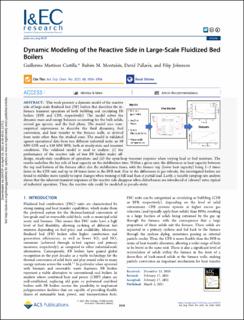| dc.contributor.author | Martinez-Castilla, Guillermo | |
| dc.contributor.author | Mocholí Montañés, Rubén | |
| dc.contributor.author | Pallarès, David | |
| dc.contributor.author | Johnsson, Filip | |
| dc.date.accessioned | 2021-05-05T13:40:57Z | |
| dc.date.available | 2021-05-05T13:40:57Z | |
| dc.date.created | 2021-03-03T23:49:05Z | |
| dc.date.issued | 2021 | |
| dc.identifier.citation | Industrial & Engineering Chemistry Research. 2021, 60 3936-3956. | en_US |
| dc.identifier.issn | 0888-5885 | |
| dc.identifier.uri | https://hdl.handle.net/11250/2753742 | |
| dc.description.abstract | This work presents a dynamic model of the reactive side of large-scale fluidized bed (FB) boilers that describes the in-furnace transient operation of both bubbling and circulating FB boilers (BFB and CFB, respectively). The model solves the dynamic mass and energy balances accounting for the bulk solids, several gas species, and the fuel phase. The model uses semi-empirical expressions to describe the fluid dynamics, fuel conversion, and heat transfer to the furnace walls, as derived from units other than the studied ones. The model is validated against operational data from two different industrial units: an 80 MW CFB and a 130 MW BFB, both at steady-state and transient conditions. The validated model is used to analyze: (i) the performance of the reactive side of two FB boilers under off-design, steady-state conditions of operation; and (ii) the open-loop transient response when varying load or fuel moisture. The results underline the key role of heat capacity on the stabilization time. Within a given unit, the differences in heat capacity between the top and bottom of the furnace affect also the stabilization times, with the furnace top (lower heat capacity) being 1–3 times faster in the CFB unit and up to 10 times faster in the BFB unit. Due to the differences in gas velocity, the investigated boilers are found to stabilize more rapidly to input changes when running at full load than at partial load. Lastly, a variable ramping rate analysis shows that the inherent transient responses of the reactive side disappear when disturbances are introduced at (slower) rates, typical of industrial operation. Thus, the reactive side could be modeled as pseudo-static. | en_US |
| dc.language.iso | eng | en_US |
| dc.publisher | ACS | en_US |
| dc.rights | Navngivelse 4.0 Internasjonal | * |
| dc.rights.uri | http://creativecommons.org/licenses/by/4.0/deed.no | * |
| dc.title | Dynamic Modeling of the Reactive Side in Large-Scale Fluidized Bed Boilers | en_US |
| dc.type | Peer reviewed | en_US |
| dc.type | Journal article | en_US |
| dc.description.version | publishedVersion | en_US |
| dc.rights.holder | The Authors | en_US |
| dc.source.pagenumber | 3936-3956 | en_US |
| dc.source.volume | 60 | en_US |
| dc.source.journal | Industrial & Engineering Chemistry Research | en_US |
| dc.identifier.doi | 10.1021/acs.iecr.0c06278 | |
| dc.identifier.cristin | 1895501 | |
| cristin.ispublished | true | |
| cristin.fulltext | original | |
| cristin.qualitycode | 2 | |

